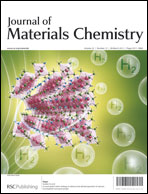Ordered mesoporous structures were successfully introduced into Nafion membranesvia a soft micelle templating method, using a non-ionic block copolymer surfactant, PEO127–PPO48–PEO127 (Pluronic F108). Atomic force microscopy (AFM) and small angle X-ray scattering (SAXS) analysis show the typical features of the formation of ordered mesopores in the as-prepared Nafion membranes. TGA and FTIR results show that the mesoporous Nafion (meso-Nafion) has a much higher water retention capability as compared to conventional Nafion membranes. The proton conductivities of meso-Nafion are much higher than those of Nafion 115 membranes especially at reduced relative humidity (RH) and elevated temperatures. The results show that the conductivity and water retention ability are sensitive to the surfactant loading. At 80 °C and 40%RH, the conductivity of the best meso-Nafion membrane is 0.07 S cm−1, 5 times better than 0.013 S cm−1 obtained on Nafion 115. At 60%RH and 80 °C, the cell with meso-Nafion reached a stable power output of 0.63 W cm−2, more than 2 times higher than the cell with pristine Nafion 115 under identical experimental conditions. When the RH reduced to 20%, the power output of meso-Nafion membranes is 5.6 times higher than that of Nafion 115. The cells with meso-Nafion membranes also demonstrate much better power output at elevated temperature of 120 °C and reduced humidity.

You have access to this article
 Please wait while we load your content...
Something went wrong. Try again?
Please wait while we load your content...
Something went wrong. Try again?


 Please wait while we load your content...
Please wait while we load your content...